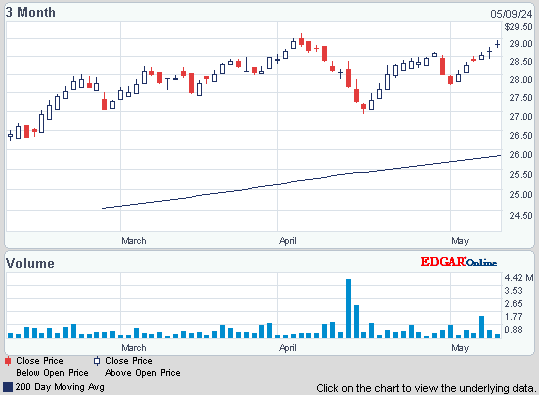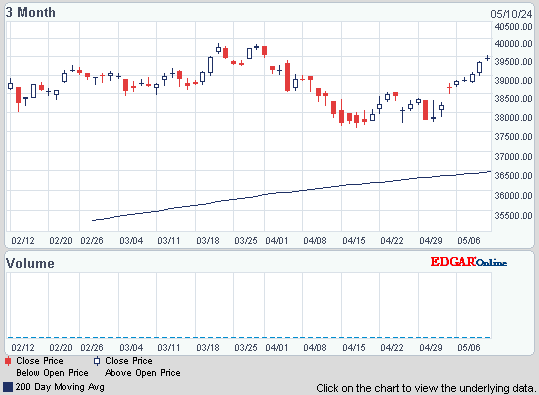Dow slipped 3, advancers ahead of decliners 2-1 & NAZ rose 7. Higher bank stocks pushed the Financial Index up a fraction in the 213s (close to its recent highs).
The MLP index fell 1+ to the 390s while the REIT index was essentially even at its yearly highs of 254. Junk bond funds were mixed & Treasuries rose on mixed economic news. Oil & gold had modest changes.


Photo: Bloomberg
Unemployment in the Euro-region rose to the highest in more than 14 years & manufacturing contracted for an 8th month, adding to signs the economy slipped into a recession in Q1. The jobless rate in the 17-nation euro area rose to 10.8% in Feb, up from 10.7% a month earlier, according to the EU statistics office. That’s the highest since Jun 1997 & close to the record of 10.9%. A manufacturing gauge, based on a survey of purchasing managers, fell to 47.7 in Mar from 49, according to Markit Economics. Europe's economy has been mired in a fiscal crisis for more than 2 years, forcing companies to cut jobs & pushing economies from Spain to Ireland into recessions. To help contain the crisis, finance ministers decided last week to boost the rescue-lending capacity to €800B ($1.1T), a figure that includes €300B already committed to Greece, Ireland & Portugal. The ECB said that the firewall is “sufficient.” In Germany, Europe’s largest economy, the jobless rate held at 5.7% in Feb based on a trend component while unemployment in France remained at 10%. In Italy, the jobless rate rose to 9.3% from 9.1% & Spain had the highest rate at 23.6%. Markit’s euro-area manufacturing gauge dropped to a 3- month low in Mar. A German indicator fell to 48.4 from 50.2 the previous month, while in France the number slipped to 46.7 from 50. Europe is an important market for US companies & multi national's have major investments in European subsidiaries.
Euro-Region Unemployment Surges to 14-Year High, Nears Record
The news is better in the US. The Institute for Supply Management said that its index of manufacturing activity rose to 53.4 in Mar, up from 52.4 in the previous month. Readings above 50 indicate the sector is expanding. A measure of employment in the sector rose to a 9 month high, a sign that factories are stepping up hiring & manufacturers are already a big source of job gains. They've added more than 100K jobs in the past 3 months, about one-seventh of all net gains. Businesses also ordered more durable goods in Feb, after a steep drop the previous month, a report last week showed. Greater demand for machinery, computers, autos & aircraft drove the increase. Orders for "core" capital goods, a key measure of business investment plans, also rose after falling in Jan by the most in a year (after an investment tax credit expired). A recovery in auto sales has been a big reason for the strength in manufacturing. Americans delayed auto purchases during the recession which led to sharp increases in car sales as the economy recovered. More auto manufacturing boosts output in an array of industries, including steel, tire makers, & other parts suppliers.
Manufacturing in U.S. Expanded at a Faster Pace in March
However US builders trimmed activity for a 2nd straight month in Feb, pushing construction spending down by the largest amount in 7 months. There was widespread weakness with spending on home building, office construction & gov projects all dropping. The Commerce Dept reported that construction spending fell 1.1% in Feb after a drop of 0.8% in Jan which was revised down from an initial estimate of a decline of only 0.1%. With the back-to-back declines, construction spending stood at an annual rate of $809B in Feb, just 6.1% above a low hit in Mar 2011 & about a third lower than the high hit during the housing boom. The weakness last month came from a 1.5% drop in construction of single-family homes which offset a 2% rise in apartment construction. Spending on non-residential construction projects dropped 1.6% following a 2.3% decline in Jan. The Feb decline reflected weakness in office construction, hotels & shopping malls. Gov construction dropped 1.7% to an annual rate of $282B with state & local building projects down 2.1% while spending by the federal gov rose 1.9%. This data mutes other recent more favorable housing data. The housing recovery is fragile & stumbling.
Construction Spending in U.S. Unexpectedly Declined in February
Q2 started off with a yawn from the markets as markets are back to spinning their wheels. Dow had broken thru the 13K ceiling in a convincing fashion, but then the bulls went home. This may reflect nervousness about earnings seasons, even though expectations are not high. The big jobs report will be released on Fri, another unknown to worry about.

The MLP index fell 1+ to the 390s while the REIT index was essentially even at its yearly highs of 254. Junk bond funds were mixed & Treasuries rose on mixed economic news. Oil & gold had modest changes.
JPMorgan Chase Capital XVI (AMJ)
Treasury yields:
U.S. 3-month | 0.066% | |
U.S. 2-year | 0.329% | |
U.S. 10-year | 2.182% |
| CLK12.NYM | ...Crude Oil May 12 | ...102.65 | ... | (0.4%) |
| GCJ12.CMX | ....Gold Apr 12 | .........1,677.10 | ... | (0.5%) |
Get the latest daily market update below:

Unemployment in the Euro-region rose to the highest in more than 14 years & manufacturing contracted for an 8th month, adding to signs the economy slipped into a recession in Q1. The jobless rate in the 17-nation euro area rose to 10.8% in Feb, up from 10.7% a month earlier, according to the EU statistics office. That’s the highest since Jun 1997 & close to the record of 10.9%. A manufacturing gauge, based on a survey of purchasing managers, fell to 47.7 in Mar from 49, according to Markit Economics. Europe's economy has been mired in a fiscal crisis for more than 2 years, forcing companies to cut jobs & pushing economies from Spain to Ireland into recessions. To help contain the crisis, finance ministers decided last week to boost the rescue-lending capacity to €800B ($1.1T), a figure that includes €300B already committed to Greece, Ireland & Portugal. The ECB said that the firewall is “sufficient.” In Germany, Europe’s largest economy, the jobless rate held at 5.7% in Feb based on a trend component while unemployment in France remained at 10%. In Italy, the jobless rate rose to 9.3% from 9.1% & Spain had the highest rate at 23.6%. Markit’s euro-area manufacturing gauge dropped to a 3- month low in Mar. A German indicator fell to 48.4 from 50.2 the previous month, while in France the number slipped to 46.7 from 50. Europe is an important market for US companies & multi national's have major investments in European subsidiaries.
Euro-Region Unemployment Surges to 14-Year High, Nears Record
The news is better in the US. The Institute for Supply Management said that its index of manufacturing activity rose to 53.4 in Mar, up from 52.4 in the previous month. Readings above 50 indicate the sector is expanding. A measure of employment in the sector rose to a 9 month high, a sign that factories are stepping up hiring & manufacturers are already a big source of job gains. They've added more than 100K jobs in the past 3 months, about one-seventh of all net gains. Businesses also ordered more durable goods in Feb, after a steep drop the previous month, a report last week showed. Greater demand for machinery, computers, autos & aircraft drove the increase. Orders for "core" capital goods, a key measure of business investment plans, also rose after falling in Jan by the most in a year (after an investment tax credit expired). A recovery in auto sales has been a big reason for the strength in manufacturing. Americans delayed auto purchases during the recession which led to sharp increases in car sales as the economy recovered. More auto manufacturing boosts output in an array of industries, including steel, tire makers, & other parts suppliers.
Manufacturing in U.S. Expanded at a Faster Pace in March
However US builders trimmed activity for a 2nd straight month in Feb, pushing construction spending down by the largest amount in 7 months. There was widespread weakness with spending on home building, office construction & gov projects all dropping. The Commerce Dept reported that construction spending fell 1.1% in Feb after a drop of 0.8% in Jan which was revised down from an initial estimate of a decline of only 0.1%. With the back-to-back declines, construction spending stood at an annual rate of $809B in Feb, just 6.1% above a low hit in Mar 2011 & about a third lower than the high hit during the housing boom. The weakness last month came from a 1.5% drop in construction of single-family homes which offset a 2% rise in apartment construction. Spending on non-residential construction projects dropped 1.6% following a 2.3% decline in Jan. The Feb decline reflected weakness in office construction, hotels & shopping malls. Gov construction dropped 1.7% to an annual rate of $282B with state & local building projects down 2.1% while spending by the federal gov rose 1.9%. This data mutes other recent more favorable housing data. The housing recovery is fragile & stumbling.
Construction Spending in U.S. Unexpectedly Declined in February
Q2 started off with a yawn from the markets as markets are back to spinning their wheels. Dow had broken thru the 13K ceiling in a convincing fashion, but then the bulls went home. This may reflect nervousness about earnings seasons, even though expectations are not high. The big jobs report will be released on Fri, another unknown to worry about.
Dow Industrials
Get your favorite symbols' Trend Analysis TODAY!


No comments:
Post a Comment